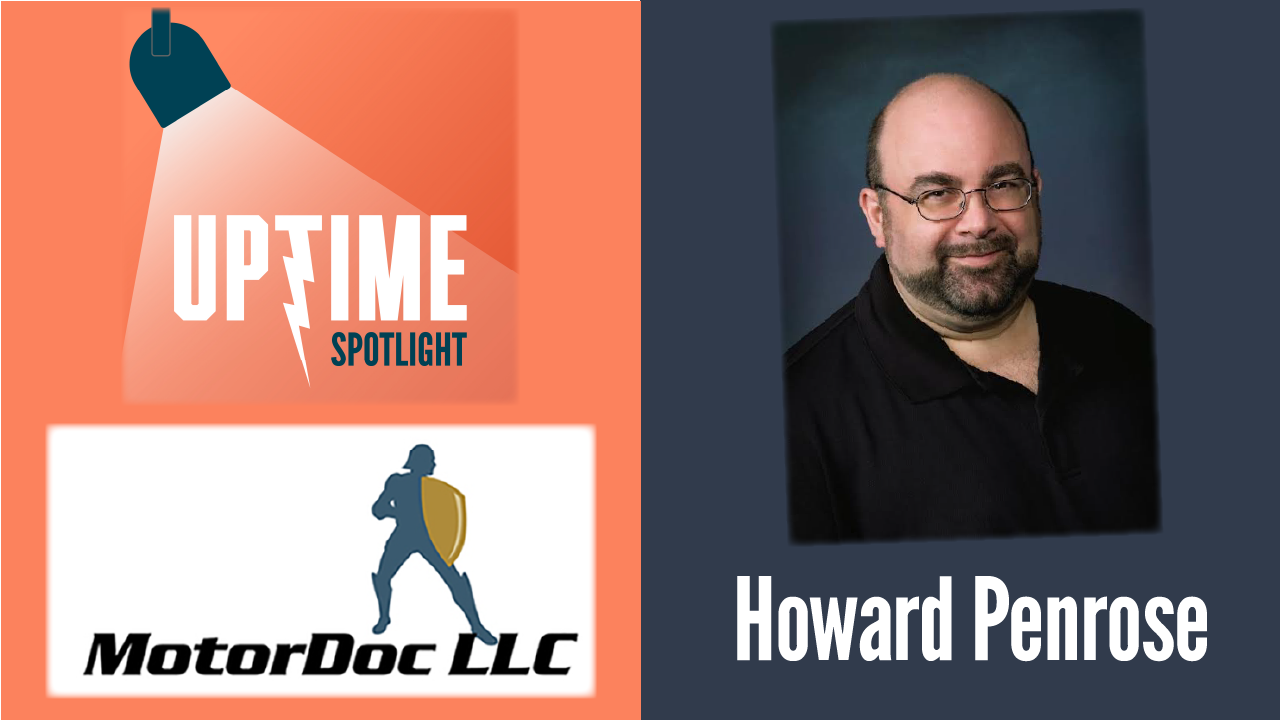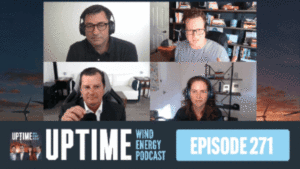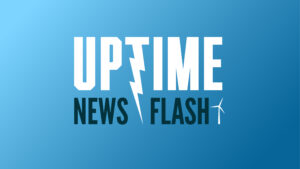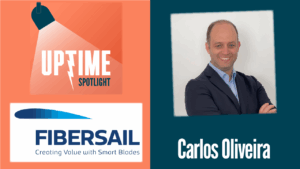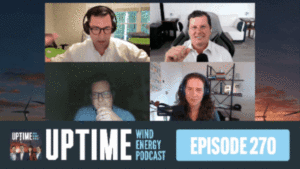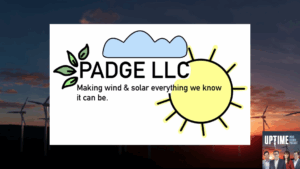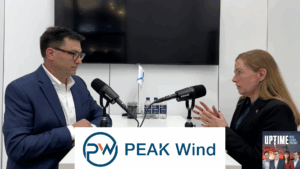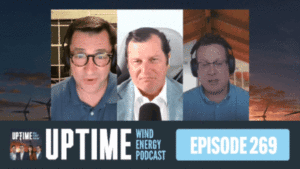Podcast: Play in new window | Download
Howard Penrose from MotorDoc discusses their electrical signature monitoring for wind turbines that offers precise diagnostics, enabling cost-effective preventative maintenance and lifetime extension.
Sign up now for Uptime Tech News, our weekly email update on all things wind technology. This episode is sponsored by Weather Guard Lightning Tech. Learn more about Weather Guard’s StrikeTape Wind Turbine LPS retrofit. Follow the show on Facebook, YouTube, Twitter, Linkedin and visit Weather Guard on the web. And subscribe to Rosemary Barnes’ YouTube channel here. Have a question we can answer on the show? Email us!
Welcome to Uptime Spotlight, shining Light on Wind. Energy’s brightest innovators. This is the Progress Powering tomorrow.
Allen Hall: Howard, welcome back to the show. Thank you. Well, we’ve been traveling a, a good deal and talking to a lot of operators in the United States and in Europe, and even in Australia. And, uh, your name comes up quite a bit because we talk to all the technical people in the world and we see a lot of things. And I get asked quite a bit, what is the coolest technology that I don’t know about?
And I say, Howard Penrose MotorDoc. And they say, who? And I say, well, wait a minute. If you want something super powerful to learn about your turbine, that is easy to implement and has been vetted and has years of in-service testing and verification. It is MotorDock, it is [00:01:00] empower for motors, it is empath for systems and vibration and all the other things.
And now empath, CMS, which is a continuous monitoring system that you’re offering that those systems are revolutionary and I don’t use that word a lot in wind. It’s revolutionary in wind and. Let, let me just back up a little bit because I, I want to explain what some of these problems are that we’re seeing in the field and, and what your systems do.
But there’s a, the, the core to what your technology is, is that you’re using the air gap between the rotor and the stator and the generator to monitor what’s happening inside the turbine. Very precisely. Can you just provide a little insight like how that magic happens?
Howard Penrose: Okay. It’s, it’s basically, we use it as an, as a basic accelerometer.
So, um, the side to side movement of the, of the rotor inside the air gap. Um. I could get very technical and use the word [00:02:00] inverse square law, but basically in the magnetic field I’ve got side to side movement. Plus every defect in the powertrain, um, causes either blips or hesitations in the rotation.
Basically, the torque of the machine, which is also picked up in the air gap, and from a physics standpoint. The air gap, the magnetic field, can’t tell the difference. And, um, both voltage and current see that as small ripples in the wave form, and then we just pull that data out. So, um, uh, I, I liken it exactly as vibration.
Just a different approach,
Allen Hall: right? And that that vibration turns into little ripples. And then I’m gonna talk electrical engineering, just for a brief moment, everybody. We’re taking it from the time domain to the frequency domain. We’re doing a four a transform. And in that four a transform, you can see these spikes that occur at, uh, known locations that correlate back to what the machine is doing
Howard Penrose: exactly.
[00:03:00] They’re they’re exact calculations, uh, down to the hundred or even thousandths of a hertz. Uh, so, uh, when we, when we do the measurements, they come up as side bands around, uh, whatever. The, the, uh, signature is, so the amplitude modulation, it’s an amplitude modulated signal. So I have, uh, basically the ripple show up on the positive side of the waveform and on the negative side of the waveform.
So around everything, I just have plus and minus line frequency. That’s, that’s basically the primary difference. Then we just convert it over to decibels, which makes it, um, relational to the load, which means load doesn’t matter. Uh, so I can compare an unloaded machine to a fully loaded machine and get the same results,
Allen Hall: which is also amazing.
So the load, what the turbine is doing doesn’t really matter at all, as long as it’s rotating and producing power. You can [00:04:00] monitor what’s happening, sort of anything up, and then the cell. Mostly,
Howard Penrose: well, it’s even, it’s even more fun than that because the air gap in a wind turbine is at a fixed speed for a dfi.
So, uh, it’s constantly turning at the exact same speed, which is basically all I need regardless of the physical speed. So, vibration, I need to know that physical speed and electrical signature. I need to know the air gap. Speed.
Allen Hall: So with this data and the way you’re monitoring what’s happening on the turbine is through current sensors on the feeds and voltage probes.
You could do one or the other and, and you’ve done both, and we can discuss that for a moment. But just using the what’s happening on the wires, on the generator wires, now he can determine everything that’s generally happening mechanically. So from gearbox to the blades. The, [00:05:00] the hub, uh, you can even determine things that are happening up tower a little bit like ya motors and that sort of thing.
If they’re acting weird, you can see changes there. And it’s sort of like the pulse of the turbine
Howard Penrose: and the main bearings. And the main bearings, right? So all the bearings never leave out the main bearings. That’s, that’s a study we’re involved in right now. So, um. Yeah. Uh, oh. Yeah. The, the study right now is, uh, we’re using the technology to map out circulating current sub tower.
Um, so we’re, we’re looking at, uh, why main bearings are failing, um, which was missed before. I’ve got an, I’ve got a paper coming out on it. We’re kicking off an NRE L study, uh, on it. And we are also working along with, um, groups in the field and an independent study all to. Well, a main bearing is a really expensive issue.
Um, and, and we’re fine. People are just [00:06:00] finally figured out that they were failing because of electrical discharge. And, um, the high frequencies associated with that basically caused the brushes to become resistors and the bearings to become conductors. So, uh, we now have a technology that allows us to look at these very high frequency sound or.
High frequency
Allen Hall: noise. Okay. Let’s just use that as a test case for your system for iPath CMS, because. That is one issue that pretty much everybody in the United States that uses a particular OEM has
Howard Penrose: actually, uh, you, you got, you hit it on the head. It’s just like the old W Ring thing. Everybody thought it was a specific, uh, generator manufacturer turned out to be every DFI failing the same way we discovered that.
Uh, we’ve also heard, uh, you know, a specific OEM and a specific. Type of platform. They were seeing the problems in the main bearings. And again, it just came about because people were talking about it. Except [00:07:00] guess what? We’re not just seeing it in the us, we’re seeing it globally. That’s one of the benefits we have with so many users worldwide is we’re finding out that all of these problems are not unique to us.
They’re global in nature and they’re cross platform.
Joel Saxum: So when we talk cross platforms and, and you, the listeners here will notice that I’ve been markedly absent from the conversation so far. ’cause it’s a bit over my head. Sorry. No, it’s, it’s just, this is, this is great stuff. But what I, that was one of the things I was wondering while we were going through this is we were talking about, um.
Solutions that you guys have that can solve specific problems. Now, does this say I have a direct drive turbine? Or like, is, is there any models or any types of technology that you can’t work on out in the field or does it Basically we have a solutions that can cover all turbines regardless
Howard Penrose: if it’s got a magnetic field, whether it’s a generator, motor, or transformer, we can see it.
I can follow that. So we even, we even, we even use [00:08:00] the technology in the industrial side for power monitoring for plants. Because we get, uh, we get good insights on what’s coming into the facility and what the facility’s putting back into the system, in particular with high frequency noise and stuff like that, that utilities are just now starting to pay attention to.
Joel Saxum: It’s just, this is an important thing for the CMS system that you guys have, because I’m, I’m thinking right now, okay, now, now again, I’m gonna dumb this way down, um, in my. Built Jeeps that I’ve done in the past, I’ve gotten death wobble in the steering wheel because of oscillations in the front axle.
Right? But that only happens at a certain speed, right? If I, if I could, if I could get through second gear at about 4,000 RPMs and grab third, I’m fine. But if I have to shift to 2,500 RPMs, about 32 miles an hour, I’m in a world of hurt, right? I’m, I’m shaking this thing down the road. So turbines I know will do that sometimes at certain RPM.
They will have vibration issues that will either go away or expand a resonance or natural [00:09:00] frequency.
Howard Penrose: Yeah,
Joel Saxum: right. Like at, at at, um, you know, four RPM is one thing at seven and a half rpm it goes away. So having cm, your CMS system, that’s their continuously monitoring when the wind speeds are low, when they’re high, when.
Does that help you pick up different anomalies within the turbine to be able to kind of pinpoint what’s, what could be happening?
Howard Penrose: No, because those frequencies are always present. They just amplify at certain points in speed, right? They, they hit a natural frequency, so they just oscillate like mad. Uh, I’m rereading all of my Tesla books right now.
So where, where he talks about that, you know, you could split the world like an apple if, if you hit the right frequency. Um. With a small device. Uh, so, uh, yeah, we see it across that entire speed range, even though you feel that oscillation. One of the nice things about, um, uh, electrical and current signature is it isn’t a structural vibration analysis.
Like if, if I [00:10:00] have the, um, structure or the machine vibrating outside, I see very little of that. I see all the drivers behind it instead. Right. So it, it’s, it’s less likely, uh, I’ll pick up a false positive because I hit a resonance. That amplitude remains the same.
Joel Saxum: That’s the difference between what you guys are doing and what and what everybody else is doing with a accelerometer, gy, gyro, whatever that sensor may be.
You name it,
Howard Penrose: accelerometer, ultrasound, all that other stuff. It’s all variations of,
Joel Saxum: of physical.
Howard Penrose: Yeah, and I refer to those as basically fault detectors. They’re dummy lights. Nobody’s actually using condition-based maintenance as condition-based maintenance. We can use the information to actually make modifications and changes.
Joel Saxum: You can actually diagnose with yours. That’s what we always say right now. CMS basically at, at this, at a general level is go and look at this turbine, bing. Go and [00:11:00] look at this turbine. You have a problem. Go and look. One of these blades has a problem. Go and look at it. But you are actually going deeper down saying diagnosis, Hey, this may be the actual problem that’s causing.
This issue in your turbine, and that is invaluable.
Howard Penrose: Yeah. One of our case studies is of a bearing a man, a a a a re, a reinstalled bearing on a, or an installed bearing on a drive end of a a wind turbine. The, um, it had some problems with, uh, the cage, which caused one of the roll balls not to rotate. Um, and it had some false brunel on in the inner outer race, and we saw that, but we also saw, uh, a much higher level in the thrust bearing in the gear box.
And so when we, we went back to them and said, yeah, you’ve got a problem here. Uh, they took the bearing back off, and then I said, make sure that you’ve got all the shims in the. And the, uh, coupling and they had left out a shem, so it had [00:12:00] caused a problem in the, so if we hadn’t detected the other thing, we would’ve detected the gearbox, um, bearing.
But they were ignoring that data and were looking at the bearing. They just replaced in the generator. So when, when they put everything back together, we were able to confirm that. All we saw after that was the friction losses in the, in the bearings.
My
Joel Saxum: question is, is okay, we’re looking at. Basically deltas outside of a, a sine wave and these peaks and valleys to in your, in the sign you’re detecting, how are you able to know, oh, I saw this delta here, or I saw this here.
That’s a thrust bearing. That’s a main bearing. That’s something here. Is that just years of knowledge built up from, okay, we saw this fault and we, we figured it was this because of it, or. How are you guys arriving at that?
Howard Penrose: Uh, it’s from my years as a, uh, vibration analyst, um, Navy trained vibration analyst.
Uh, [00:13:00] so, um, what, what was discovered by Oak Ridge National Labs in the 1980s? So this isn’t that new. As a matter of fact, this technology is direct descendant from Howard Haynes’s work another Howard. What we discovered was the frequencies are. For the most part, exactly the same as what we look for in vibration, just side bands, right?
Because we, we, you know, I tell people, how do you interpret the data versus vibration? Stand on your head and cross your eyes. Um, being former Navy, I sometimes use some other, you know, things such as go out and drink heavily. Uh, but in any case, um. Instead of looking from bottom up, we’re actually setting whatever the peak line frequency, current or voltage is, that’s zero.
And then we, uh, relate every other peak, um, based upon 20 times the log 10 of the difference in the current, from the current in [00:14:00] question back to that peak. Which is kind of cool because that also means that it’s. As my load changes, everything follows. So it’s not load dependent. The only thing that happens is frequency.
So you have to take enough of a, a data across a long enough time so that you can determine the differences between the, the components, right? So, so in a wind turbine for instance, I’ll have all those bearings in the gearbox, including the planetary gears. I have the main bearing, and they all kind of crowd around line frequency.
I need a resolution that’ll show me a hundredth of a hertz difference between any two peaks. It’s it’s vibration. It’s actually vibration. So the, each of the components, even each component of the bearing, ’cause I can call out which part of a bearing, and that’s actually how we analyze what conditions we’re looking at.
If it’s, uh, cage and ball only, and no signature off of the inner and outer [00:15:00] race, chances are it’s lubrication. Um, you know, that kind of thing on a main bearing. If I see the outer race cha and nothing else, chances are, uh, they didn’t clean out all the old grease and there’s dried grease across the bottom.
Uh, we discovered that actually with a couple of the, a couple of sites. So we, we say check, check greasing and condition of the inner and outer rays, you know, that kind of thing. And, uh, we’ve been right more than wrong. Uh, the, the quoted, the quoted number back from one of the OEMs is about 95% accuracy.
And when you consider, when you consider borescope has been identified at less than 50%, um, it, it, it gives you a really high accuracy.
Joel Saxum: We just had a conversation with someone the other day, Alan, you and I, about borescopes and how can you borescope so think that’s full of grease And they were like, oh, yeah.
Allen Hall: Yeah, it’s difficult.
At best. Well, and that’s the power of [00:16:00] what Modoc is doing, and what Howard’s doing is that it can detect a range of problems early. And as we get into this area of where o and m budgets are becoming restricted, and you need to spend your money wisely. Do preventative maintenance, which is what MotorDoc is all about, is catching these things early before they become really expensive.
Electrical signal analysis is a very simple way to get that data, which is what the Empower Empath and then Empath CMS system are doing is they’re, they’re reading those electrical signatures and correlating back to where the problem is and the success rate is. Howard, as you pointed out, is. Really high, uh, a lot of systems that I see and I was just went to Europe and looked at some data on some other systems, it’s about 50 50.
Well, if 50 50, I could flip a coin at that point. It’s not of any use to me. It has to be somewhere north of 90 where I become interested. And your system, when I talked to operators that use it, [00:17:00] said, well, geez, um, you know, it’s well in the high, in the nine high nineties all the time and it’s amazing what they can pull out.
It’s this bearing or that bearing or this problem with this motor or this problem with the system and the amount of money they’re saving to pick up those problems early and to get them repaired when it’s lower cost or to keep an eye on ’em even, which is an option, lowers our operational budgets down and it makes sense.
So the, the cost of a CMS system is only relative to the money it saves. And I think this is where a lot of operators are getting a little hung up. There’s a lot of CMS systems, which are you pay per year for, and it’s a constant expanse. It adds up to the om OMS budget and no one wants to do that. What you’re seeing now with MotorDock is that system is a capital expenditure.
You buy it, it comes with the hardware, it comes with the [00:18:00] software, it comes with all the knowledge and all the updates I think are free. So. It makes a lot more sense to use a MotorDoc type of system and empath CMS than necessarily to, to put individual CMS systems on that maybe do less than what Howard can do.
Joel Saxum: I think an important thing here too, Alan, is as we get to, uh, an era of lifetime extension, I. People looking for that solution. How do I guarantee the safety of my turbine, the operation of my turbine as we continue to roll this thing forward? I know here, even in the states, we always say PTC, 10 year repower.
That’s not the case for all these turbines. We have 80 20 repowers. We have a lot of ’em. Like, Hey, we have a good PPA. So these things have been, these are 14 years old, we’re still gonna run ’em. We’re not repowering these, or in Europe or in other places in the world where we don’t have the same kind of tax setup we do, where they’re trying to squeeze as much life outta these in, you know, originally 20 to 25 year lifetimes.
Man, if you can put something on there that can tell you you’re good to go, or Hey, you need to watch this, or This is the next big spend you have coming up, they can help those operators to make decisions [00:19:00] to for lifetime extension in a really, really good way.
Allen Hall: Going into the data acquisition system and how it connects to the turbine, I know it’s one of the problems that we run into occasionally, is using anything that the the Tower has in terms of data streams.
They want of a lot of it information. Does your system plug into the data system of the turbine or is it independent, or how does that work and what is the security features?
Howard Penrose: Yeah, whatever they want. So, uh, that, that, and, and you bring up a good point, like wireless is not allowed. Um, but everybody’s using it, right?
Um, there’s a lot of things that aren’t allowed that we were, we were. Privy to during NIST’s work and, and others’ work on cybersecurity on the hill, because I was advising that stuff back in the, you know, back, uh, prior to 2020 and a little bit afterwards. Um, so, uh, uh, [00:20:00] yeah, we, our system was originally designed for nuclear power plants.
So, uh, it’s meant to either. It’s a wired system basically, that you can take back to an independent server. You can have it go locally and send it through your own, uh, own network. Um, it doesn’t need to connect to cloud or somewhere else. Uh, if you want to keep it itself contained. Uh, in some turbines we have gone the route of, uh, cellular modems.
For, for each of the towers. Um, you know, when, when they’re permanently installed, a lot of people just do data collection. I mean, when you consider, like in a GE turbine, um, if I go, if I personally go to a site and I’ve done over 6,000 turbines in the, in the US and Canada myself, um. And if you could see me, you know, I don’t climb.
[00:21:00] Um, yeah, that’s my running joke. It’s like, yeah, I don’t think the ladders will support me. Uh, but any case, um, the, uh, normally it’s walking the base of the tower gathering data as long as the transformer’s down tower and moving on to the next one, I, I think my record is seven minutes a tower, including traveling in between.
So it’s not unusual to knock out a single data collection on a site within, uh, if it’s 120 turbines, normally three days. Three and a half. If there’s a, if it’s summer and they’ve got that wind break in Texas where, you know, it’s changing direction, so it takes a lunch break.
Joel Saxum: You’re a small company, right?
Just like we are here at Weather Guard where we’re flexible to what the client wants. So if the client wants a certain thing, we can deliver a certain thing. If the client needs this, they can, we can do this. So you get, you guys can do the, the CMS UPT Tower where it’s like you have an installation and it’s gonna be there.
Or hey, we can just come to your site, boom, boom, boom, do some testing, and be outta there and give you some reports like you can, you [00:22:00] have a lot of solutions that you can help people out with.
Howard Penrose: We even have, uh, most of the, um, uh, wind service companies, you know, motor repair shops and generator repair shops and everything else have our technology.
They also provide the service. Uh, that’s our model is the more the end users or service companies can do it, the better. Uh, we, we made the choice not to, you know, I don’t want a room full of people that are sitting there doing nothing but analysis, right? They’re gonna burn out. Uh, I’d rather be doing the research and identifying the problems, finding industry related issues to solve.
And our technology was built simple enough that we don’t have to handle a lot of tech support calls. Um, and, uh, and monitoring is an option. Meaning we’ll do the monitoring. I’ve got, I’ve got a number of industrial sites, some wind sites, some other energy sites. Uh, [00:23:00] all, all using the technology and getting us data, but yeah, exactly.
Smaller company. It’s broad, but the technology is not backed by just us. It’s backed by a small $12 billion company called ome. So, uh, yeah, so, and that’s not, it’s not an investor anything. It’s, they, um, they got the license from Oak Ridge back in 1991 or two and, uh, and they maintain it. And during some 97 on, uh, I, in different roles.
Uh, have been supporting the development of the technology. So we have a mutual agreement. They focus on, um, nuclear power, and I focus on everything else.
Allen Hall: Howard, we love having you on the program because your technology is just amazing and people need to get a hold of MotorDoc. So if you’re an operator, a developer, an OEM, and Wind, if you’re making some of the components for wind [00:24:00] turbines, you need to be talking to Howard and MotorDoc to get this diagnostic tool into your toolbox and save the the world a lot of money on downtime and repairs.
Howard, how do people get a hold of MotorDoc? Where do they find you on the web?
Howard Penrose: Well, we could be reached online, uh, through, uh, LinkedIn at, uh, LinkedIn slash in slash MotorDoc, or, uh, at our websites MotorDoc.com or MotorDoc ai.io. Uh, or you can also reach us via email at info@motordoc.com.
Allen Hall: Howard, thanks for coming on.
We’re gonna have you back on soon and everybody keep watching Howard on LinkedIn if you wanna find out what’s happening as MotorDoc develops more technology, watch Howard on LinkedIn. Howard, thank you so much for being on the program. Love having you.
Howard Penrose: It has been a pleasure as always. And we’ll see you the next time [00:25:00] around.



